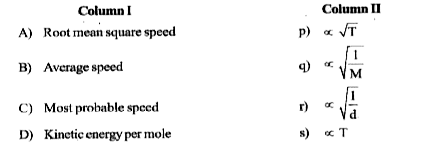Statement 1. : The pressure of a fixed amount of an ideal gas is proportional to its temperature.
Statement 2 : The frequency of collisions and their impact both increase in proportion to the square root temperature.Solution in Malayalam
Statement 1 is True, statement 2 is True, Statement 2 is Correct explanation for Statement 1.
Statement 1 is True, Statement 2 is True, Statement 2 is NOT a correct explanation for Statement 1.
Statement 1 is True, Statement 2 iş False.
Statement 1 is False, Statement 2 is True.
The correct Answer is:B
The pressure of a fixed amount of an ideal gas is proportional to its temperature ,vrms∝√T
Collision frequency is directly proportional to vrms . On increasing the collision frequency , the pressure increases .
Topper's Solved these Questions
- STATES OF MATTER Book:BRILLIANT PUBLICATIONChapter:STATES OF MATTER Exercise:LEVEL III (Linked Comprehension Type )
Explore 9 Videos
- STATES OF MATTER Book:BRILLIANT PUBLICATIONChapter:STATES OF MATTER Exercise:LEVEL III (Matching Column Type .)
Explore 7 Videos
- SOME BASIC CONCEPTS OF CHEMISTRYBook:BRILLIANT PUBLICATIONChapter:SOME BASIC CONCEPTS OF CHEMISTRYExercise:LEVEL-I
Explore 55 Videos
- STRUCTURE OF ATOMSBook:BRILLIANT PUBLICATIONChapter:STRUCTURE OF ATOMSExercise:LEVEL - III (Linked Comprehension Type)
Explore 8 Videos
Similar Questions
which of the following statements is correct?
View SolutionMatch the term with the expression.

View SolutionWhich of the following is a characteristic of both mixtures and compounds?
View SolutionThe hydrogen-like species Ļi2+ is in a spherically symmetric state S1 with one radial node. Upon absorbing light the ion undergoes transition to a state S2 The state S2 has one radial node and its energy is equal to the ground state energy of the hydrogen atom.
The state S1 is: 1s, 2s, 2p, 3s
View SolutionIn a process, the pressure of an ideal gas is proportional to square of the volume of the gas. If the temperature of the gas increases in this process, then work done by this gas
View SolutionAssertion: The pressure of a fixed amount of an ideal gas is proportional to its temperature.
Reason: Frequency of collisions and their impact both increase in proportion of the square root of temperature.
View SolutionAssertion: The pressure of a fixed amount of an ideal gas is proportional to its temperature.
Reason: The Frequency of collisions and their impact both increase in proportion of the square root of temperature.
View SolutionStatement-1: The density of an ideal gas doubles when the pressure of the gas is doubled in a closed and rigid system.
Statement-2: Density of an ideal gas is directly proportional to pressure at constant temperature.
View SolutionStatement-1. The pressure of a fixed amount of an ideal gas is proportional to its temperature. Statement-2. Frequency of collisions and their impact both increase in proportion to the square root of the temperature.
View Solutionकथन-1- स्थिर ताप पर गैस के निश्चित द्रव्यमान का आयतन दाब का व्युत्तक्रिमानुपाती होता है।
कथन-2 -वास्तविक गैस आदर्श गैस के आचरण से विचलन प्रदर्शित करती है
View SolutionThe pressure of a fixed amount of an ideal gas is proportional to its temperature . Frequency of collision and their impact both increase in proportion to the square root of temperature . True/ false.
View SolutionAssertion: The pressure of a fixed amount of an ideal gas is proportional to its temperature.
Reason: The Frequency of collisions and their impact both increase in proportion of the square root of temperature.
View Solutionवक्तव्य I एक आदर्श गैस की निश्चित मात्रा का दाब , उसके पास के समानुपाती होती है।
वक्तव्य II संघट्टय आवृत्ति तथा उसका प्रभाव दोनों , ताप के वर्गमूल के अनुपात में बढ़ते है।
View SolutionStatement I: For an ideal gas at constant temperatures the product of the pressure and the volume is constant. Statement II: The mean square velocity of the molecules is inversely proportional of mass.
View Solutionवक्तव्य I एक आदर्श गैस की निश्चित मात्रा का दाब, उसके ताप के समानुपाती होता है। वक्तव्य II संघटट्य आवृत्ति तथा उसका प्रभाव दोनों, ताप के वर्गमूलों के अनुपात में बढ़ते हैं।
View Solution(A): At constant volume on increasing temperature the collision frequency increases. (R) : Collision frequency is directly proportional to temperature of the gas
View Solution

